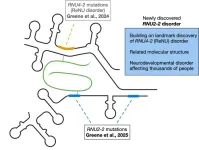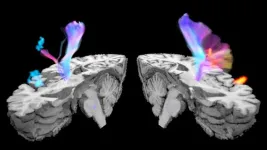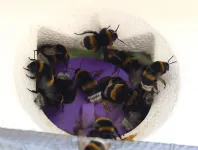(Press-News.org) Traumatic brain injury (TBI) is a serious issue affecting thousands of people in the U.S. every year. For military service members, the impact is even more profound. Since 2000, over 492,000 cases of TBI have been reported, making it one of the defining injuries of modern warfare, according to the U.S. Department of Defense. Many veterans have experienced multiple TBIs, raising concerns about long-term effects on brain health. Given the subjective and nonspecific nature of symptom presentation, treatment and prognosis can be difficult.
Researchers from UTSA, the South Texas Veterans Health Care System and UT Health San Antonio are combatting this challenge thanks to a grant from the San Antonio Medical Foundation.
Jeffrey Howard, associate professor of public health at UTSA, Alicia Swan, director of rehabilitation research at the U.S. Department of Veterans Affairs, and Sara Mithani, assistant professor at the UT Health San Antonio School of Nursing, will receive a $200,000 grant to provide insights that could revolutionize the treatment of TBI in veterans.
Using medical records, clinical assessments, surveys and other resources, the team plans to identify sub-types of TBI in veterans and to analyze associations between those TBI profiles and biomarker, behavioral and clinical outcomes. Ultimately, they will translate those findings into a dashboard that clinicians can use to treat patients with TBI.
“We want to create that immediate feedback loop to translate these findings to something that can be used by the actual clinicians who are treating these patients,” Howard explained. “The dashboard would be interactive, and the clinicians would be able to see useful data trends.”
The team is working with data from a sample of 3,000 veterans, but there’s a challenge to overcome.
The current classification for TBI is based on only a few symptomatic issues. Additionally, this classification doesn’t always account for repeated exposures or severity, so treatment plans sometimes fail.
“There’s so much variability in terms of how patients recover, what their symptoms are and how that translates into subsequent health risks later on,” Howard said. “We are using other kinds of data, like biomarkers and neurological assessments, to come up with a better way to classify TBI patients into more clinically meaningful groupings with a more physiological basis.”
With this innovative plan, the team hopes to provide the insights to create more personalized plans for clinicians to adopt.
As the PI for the research program, Howard primarily will be responsible for the development of the informatics dashboard prototype. Swan will work with the VA to recruit a panel of clinicians who will provide feedback on the dashboard, and Mithani will provide the clinical relevance and oversight to the project.
"Addressing the complexities of TBI requires a collaborative effort across institutions,” said Mithani. “By combining clinical expertise, biomedical research and data-driven approaches, we can develop innovative solutions that truly impact the lives of veterans."
The San Antonio Medical Foundation awards up to five collaborative grants each year to foster and encourage health care and bioscience research organizations to partner in new initiatives. The team hopes that with time and after feedback and fine-tuning, this clinical dashboard can be applied to a wider population of those suffering from TBI.
By redefining how clinicians understand and treat brain trauma in veterans, this innovative project offers hope to a population that sometimes falls through the cracks. For veterans who have struggled with memory loss, chronic pain or the fear of a future shaped by neurodegeneration, this treatment represents more than medical progress.
"Addressing the complexities of TBI demands a unified effort. By leveraging the strengths of multiple institutions, we can accelerate discovery, refine treatment strategies and ultimately improve care for those who have served," Mithani said.
END
A new tool to improve lives after brain injury is underway at The University of Texas at San Antonio
2025-04-10
ELSE PRESS RELEASES FROM THIS DATE:
Guinea pigs: A promising animal model to study the human embryo
2025-04-10
The first few days of a human embryo’s development, known as pre-implantation, are important. It’s when the first cells are formed, and these decide if the embryo can survive, how it will implant in the womb and how the tissues of the fetus will develop.
Today there are still logistical, ethical and legal limitations to using human embryos for research purposes, so scientists use alternative models including stem cell-based and animal models.
In a new study published in Nature Cell Biology, Sophie Petropoulos, a researcher ...
The rise of "gut feelings" in US political rhetoric
2025-04-10
Discussion of "alternative facts" has gained sad notoriety in US politics. Yet the question has been around much longer: How do people conduct political debates – is the focus more on facts or personal opinions? A team of international researchers led by the Cluster of Excellence "The Politics of Inequality" looked into the matter. The researchers examined political rhetoric in eight million speeches by members of the US Congress between 1879 and 2022 to see if the focus of their language was more on data and facts or personal convictions and subjective interpretations.
The team noticed a significant decline in the use of evidence-based political ...
How mothers adapt to the metabolic demands of nursing
2025-04-10
Nursing poses major metabolic demands on mothers, to which they respond by eating more and saving energy to sustain milk production. There are significant hormonal changes during lactation, but how they lead to metabolic adaptations in nursing mothers remained unclear. In this study, which appeared in Nature Metabolism, leading researchers at Baylor College of Medicine and Pennington Biomedical Research Center uncovered a mechanism that connects prolactin, estrogen, the brain and metabolic adaptations during lactation.
“We worked with animal models to investigate ...
Caspian Sea decline threatens endangered seals, coastal communities and industry
2025-04-10
UNDER EMBARGO UNTIL THURSDAY 10 APRIL, 10AM LONDON TIME, 5AM EASTERN TIME.
Urgent action is needed to protect endangered species, human health and industry from the impacts of the Caspian Sea shrinking, research led by the University of Leeds has found.
Water levels in the Caspian Sea – the world’s largest landlocked water body – are getting lower, as hotter temperatures cause more water to evaporate than is flowing in. Even if global warming is limited to below 2°C, ...
Landmark study identifies new genetic cause of neurodevelopmental disorders, bringing long-awaited answers to families
2025-04-10
New York, NY [April 10, 2025]—A seminal study from researchers at the Icahn School of Medicine at Mount Sinai and their collaborators in the United Kingdom, Belgium, Spain, the Netherlands, and Iceland has uncovered a new genetic cause of neurodevelopmental disorders (NDDs). The discovery offers both closure and hope to potentially thousands of families worldwide who have long been searching for answers.
The study, published in the April 10 online issue of Nature Genetics [DOI: 10.1038/s41588-025-02159-5], reveals that mutations in a small, previously overlooked non-coding gene called RNU2-2 are responsible for relatively common NDD. Non-coding genes ...
Scientists create “metal detector” to hunt down tumors
2025-04-10
Researchers have created a “metal detector” algorithm called PRRDetect to hunt down vulnerable tumours, in a development that could one day revolutionise the treatment of cancer.
In a paper published today (Thursday 10th April) in Nature Genetics, scientists funded by Cancer Research UK and the National Institute for Health and Care Research (NIHR) analysed the full DNA sequence of 4,775 tumours from seven types of cancer. Based at the University of Cambridge and NIHR Cambridge Biomedical Research Centre, they used that data from Genomics England’s 100,000 Genomes ...
New USC study identifies key brain networks behind post-stroke urinary incontinence
2025-04-10
A new USC-led study using functional magnetic resonance imaging (fMRI) reveals the neural mechanisms that contribute to urinary incontinence, a common condition affecting stroke survivors that has a significant impact on their quality of life.
The research, just published in Stroke, was conducted by a multidisciplinary team of urologists, neurosurgeons, and imaging experts from the Keck School of Medicine of USC, Keck Medicine of USC, the Rancho Los Amigos National Rehabilitation Center, and the Shirley Ryan Ability Lab. The team discovered significant differences in brain activity during voluntary versus involuntary bladder contractions, presenting potential pathways for targeted therapies.
Urinary ...
Hidden potential in multiple disabilities
2025-04-10
Using eye-tracking — a technique for recording and analysing eye movements — a team from the University of Geneva (UNIGE) has shown that individuals with multiple disabilities can improve their social and emotional skills. Although these patients are often considered ‘‘untestable’’, nine young people have undergone personalised training over a period of one year, with promising results in terms of their ability to socialise. This work opens the way to new methods of assessment and support. It is published in Acta Psychologica.
Multiple disabilities involve a combination of severe intellectual and motor impairments, resulting in profound dependence. ...
How to protect bumblebee colonies safe from killer moths? Keep honeybee hives away from them
2025-04-10
Since the pandemic, we are very aware of the power of social distancing to protect against infectious disease. But can social distancing be effective if the infectious agent isn’t a virus or bacterium, but an insect powered by a brain and wings, and with the instinct to seek out new hosts?
Now, a study published to Frontiers in Bee Science has shown that physical distance does play a leading role in protecting bumblebees against a flying insect parasite, the bumblebee wax moth Aphomia sociella. The source of the potentially lethal infection was another species, namely nearby hives of domestic honeybees.
“Here we show that infestation with bumblebee wax moths is much greater ...
Rolling particles make suspensions more fluid
2025-04-10
Lacquers, paint, concrete—and even ketchup or orange juice: Suspensions are widespread in industry and everyday life. By a suspension, materials scientists mean a liquid in which tiny, insoluble solid particles are evenly distributed. If the concentration of particles in such a mixture is very high, phenomena can be observed that contradict our everyday understanding of a liquid. For example, these so-called non-Newtonian fluids suddenly become more viscous when a strong force acts upon them. For a brief moment, the liquid behaves like a solid.
This sudden thickening is caused by the particles present ...




